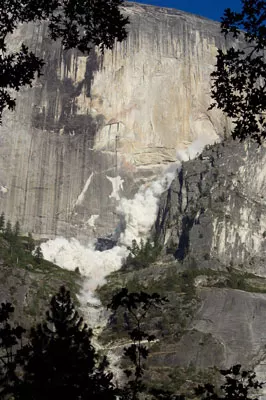Situated in the midst of the Sierra Nevada Mountains in California, Yosemite National Park stands as a majestic natural sanctuary that attracts adventurers and nature lovers from around the world. Celebrated for its breathtaking granite cliffs, majestic waterfalls, untouched alpine meadows, and rich wildlife, Yosemite is an essential destination for those looking to delve deep into the great outdoors. The park not only boasts a storied history and stunning vistas but also provides a wide range of activities and chances to engage with the natural environment.
However, visitors should exercise caution and stay informed about certain natural events occurring within the park that might impact their enjoyment. Recently, climbers in Yosemite discovered a new fissure near the Royal Arches cliff. Following an assessment, park authorities confirmed that the crack was actively widening, leading to the closure of some areas of the park as a precautionary measure to ensure visitor safety.
A new fissure has emerged, causing a large rock pillar near the Super Slide climbing area to partially separate. In response, the National Park Service has put in place trail closures to prevent the risk of falling rocks. These measures have been effective since August 30th and will be maintained until further notification.
“During the following week, a climbing ranger and a geologist had the opportunity to witness this phenomenon firsthand. They described the sound as akin to that of a frozen lake with unstable ice. Jesse McGahey, a Supervisory Park Ranger at Yosemite National Park, shared this account with Climbing, stating, ‘There were pieces of rock rattling down the crack without any direct contact.’ The park’s geologist, with 15 years of experience in Yosemite, expressed that he had never encountered anything quite like this before.” Despite the crack growing about an inch in the span of a week, the full impact of this shift is still to be determined. The concern centers around when the large granite pillar might actually fall—whether it could happen soon or take years is unknown. Until a deeper insight into this threat is gained, specific areas within the park will be restricted.
Yosemite Valley is known for its rockslides, a natural occurrence in an area shaped by glacial activity, leading to steep and imposing cliffs. These events add to the dynamic landscape of the park, though they are phenomena most would prefer to observe from a safe distance.
“Rockfalls are geological phenomena in which rocks, ranging from small boulders to massive granite slabs, break loose from the cliffs and tumble downward.” In Yosemite Valley, home to iconic granite monoliths like El Capitan and Half Dome, the frequency of rockslides is heightened by the complex geological forces at play. These slides have been a part of the valley’s history for millennia, and understanding their triggers and impacts is essential for the safety of those who visit the park and for the conservation of its natural wonders.

Numerous elements can precipitate a rockfall in Yosemite Valley, with temperature fluctuations being among the most prevalent causes. The warmth of the sunlight during the day makes the rocks expand, while the cooler temperatures at night cause them to contract. This cycle of expansion and contraction exerts stress on the rock, which can lead to the enlargement of existing cracks over time. Additionally, heavy rainfall plays a role, as it allows water to penetrate cracks, adding weight to already precarious sections of the cliffs.
The National Park Service explains, “Various factors, such as water, ice, seismic activity, and the growth of vegetation, can serve as triggering mechanisms for rockfalls. When water infiltrates fractures in the bedrock, it can exert pressure on unstable rocks. Additionally, water can seep into crevices in the rock and freeze, leading to the expansion of these cracks. This natural process, known as ‘frost wedging’ or ‘freeze-thaw,’ incrementally dislodges rocks from cliff faces.”
This mechanism of frost wedging also plays a key role in shaping the distinctive landscape of Bryce Canyon National Park in Utah, renowned for its extensive array of hoodoos.
In Yosemite Valley, where glaciers once sculpted the steep cliffs, rockfalls are a naturally recurring event. These phenomena are integral to the dynamic and evolving beauty of the park, yet they also represent a considerable risk to its visitors. Understanding the various triggers of rockfalls is vital for ensuring the safety of visitors and preserving the natural splendor of the valley.

The National Park Service notes that a variety of factors, including water, ice, seismic activity, and the growth of vegetation, can trigger the dislodgement of unstable rocks. Water infiltrating rock fractures can increase pressure and lead to rock displacement. Moreover, the intrusion of water into crevices, followed by freezing, causes these cracks to widen, a process referred to as “frost wedging” or “freeze-thaw.” This gradually pries rocks away from cliff faces, heightening the likelihood of rockfalls.
Bryce Canyon National Park in Utah showcases a landscape deeply influenced by frost wedging, housing an unparalleled quantity of hoodoos—distinctive formations carved out by natural forces over millennia.
Rockfalls play a crucial role in the geological narrative of Yosemite Valley. Although they occur abruptly and are hard to predict, advancements in understanding their triggers and the implementation of modern monitoring and mitigation techniques enable visitors to safely enjoy the splendors of this legendary national park. The phenomenon of rockfalls in Yosemite Valley highlights the continuous natural sculpting of our planet and underscores the need to maintain a balance between human activities and the conservation of natural beauty.
Adventuring in regions susceptible to rockfalls offers a thrilling experience but carries inherent dangers. The descent of rocks down steep inclines or off cliffs represents a significant hazard to safety if proper precautions are not taken. Whether you are a passionate hiker, a climber, or someone who loves exploring rocky landscapes, it is crucial to always put safety first. Here are several important safety tips to consider when navigating areas known for rockfalls.
The stunning scenery of Yosemite National Park is perpetually molded by natural phenomena like rockfalls. Although these occurrences contribute to the park’s charm, they also pose hazards to its visitors. Recognizing the fundamental reasons behind rockfalls and adhering to safety measures allows us to admire the ever-changing splendor of nature while ensuring our own safety. It’s crucial to always prioritize your safety when exploring the wilderness.










